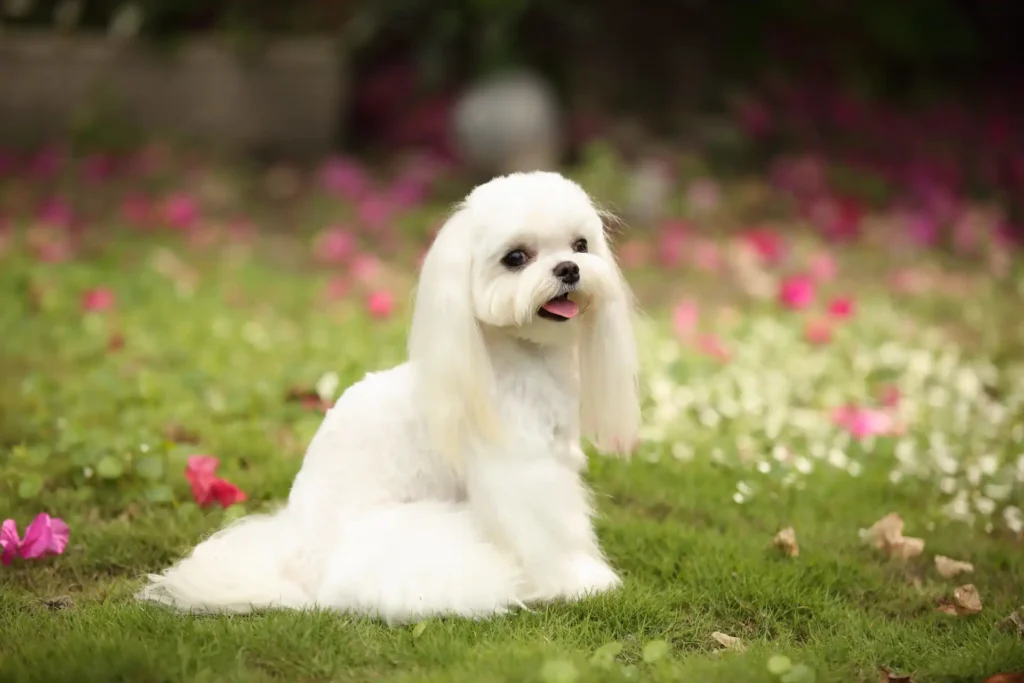When talking about the Maltese, one will immediately think of the “snow-white” and “soft hair”, just like the princesses wearing dresses in European courts! Maltese is a very popular “small pet dog” in modern times.
In fact, the Maltese has a very long history. Since the “ancient Roman times”, it has been a “popular” pet dog. Because he was so popular with “noble women”, he was even called the “Roman Lady Dog”!

7 characteristics & knowledge about the Maltese
1. Appearance characteristics
The most eye-catching thing about Maltese is the “snow-white hair”, which looks “soft and elegant”. No wonder it gives people an “elegant and cute” image at the same time! The head is an “inverted pear shape”, the ears are usually “droopy”, and the eyes are “round and big”. They are very cute and make people fall into their charm accidentally.
2. Fur color
Maltese have “only one color” of hair, which is “white”. They are a very special existence in the dog world. According to legend, this is related to the fact that in ancient times, Maltese were mostly “raised by nobles”, and the royal palace had special “control” to preserve the “purest white color”.
In addition, although Maltese are all white, “some have curly hair” and “some have very straight hair.” Those with straighter hair are more suitable for growing their hair longer.
3. Physical characteristics
The weight of an adult Maltese is usually between “2.5 and 4 kg”, and the height will fall between “20 and 25 cm”. It is a “small dog” with a similar height and length ratio, so it looks particularly “small and cute”, like a ball of marshmallows.
4. Personality traits
Maltese has a very “loving” personality, “likes to act coquettishly”, and is “highly loyal” to its owner, so it is the first choice for many people to raise a dog. Maltese are considered “easy to train” dogs. Although they cannot be used as working dogs, they are still a good choice as pet dogs.
5. Small in stature but big in ambition
Despite Maltese’s small size, when his owner encounters bad people, he is not “scared” at all and will bark loudly at others.
6. Average lifespan
The average lifespan of a Maltese is usually between “12 and 15 years”, although this may vary due to variables such as “individual differences”, “genetics” and “rearing conditions”. Because most of the “miniature” Maltese are “inbred”, they are more susceptible to “genetic diseases” and usually have a shorter lifespan.
7. Maltese are dogs raised by beautiful women? !
The “long history” of the Maltese can be traced back to the “ancient Roman period”, when it was already being raised as a pet dog by the nobles. Maltese’s “noble” and “elegant appearance” were deeply loved by aristocratic women. At that time, Maltese could even be said to be an accessory for upper-class women.
During the Renaissance, a painter painted Maltese “next to a beautiful woman.” Therefore, people at that time said that Maltese was “the dog raised by a beautiful woman.”
Is Maltese suitable for beginners? Is it easy to take care of?

About Maltese’s personality
Maltese’s personality is “gentle”, “smart”, very “sticky”, and “loyal” to its owner, so it is very suitable for novices or families to raise.
In particular, the Maltese is an “easy to train” dog, “highly obedient and sensitive”. More importantly, at critical moments, he will bravely jump out to protect you!
Are there any flaws or shortcomings in Maltese? Do you get sick easily?
1. Joint problems
Small dogs are more prone to “kneecap ectopia”, which is what we often hear as “knee dislocation”.
It is more common in small dogs that the kneecaps run to the inside, which is called “medial heterotopia”.
2. Eye problems
Maltese’s eyes are relatively “protruding”, that is to say, “the area covered by the eyelids is small.”
Because the eyelids cannot completely cover the eyes, Maltese are more likely to suffer from “keratitis” or “dry eye syndrome”.
3. Respiratory problems
Most dogs develop “tracheal collapse” in “middle age” or “middle-aged”, but small dogs are particularly susceptible, even at a very young age.
Dogs with tracheal collapse will “frequently cough” and even experience symptoms such as “difficulty breathing” and “fainting”.
4. Heart problems
Maltese are a group prone to valvular heart disease. They are most likely to have problems when they are about 6 to 7 years old and entering middle-aged and elderly years.
Since heart disease is a “chronic disease”, you need to pay more attention to it, “avoid going out in high temperatures”, “replenish water”, and “replenish fish oil”.
5. Hair grooming is troublesome
The beautiful hair of the Maltese is their greatest feature, and it is also their “trouble.”
Their hair needs to be “bathed” and “trimmed” every month, and “combed” every day, otherwise it will easily become dirty or tangled.
How much does it cost to raise a Maltese for a month?

In fact, the cost of raising a Maltese can be a lot or very little, and it will mainly vary according to the owner’s “raising method” and “dog needs”.
Basically, there will be medical expenses, food expenses, health expenses, and daily necessities expenses, which average about “more than 3,000 to 5,000 yuan a month”, but some owners may have higher expenses.
Maltese are “single-coat” dogs, so they will incur more “bathing and grooming expenses” than other dogs, which is about “2,000 yuan to 4,000 yuan” per month, depending on the region.
Before raising, you can understand the problems you may face in the future, and decide whether to raise based on your own financial ability.
Generally speaking, “the first four months cost more”, mainly “one-time expenses”, such as “chip implantation fee”, “registration fee”, and “pet neutering fee”.
In the early stage, you need “daily necessities” and “arrangement expenses” for the dog, and later on you will need “food expenses”, “medical expenses”, and “pet grooming expenses”.
And some situations may not happen as we expected, such as the related expenses of seeing a doctor when you are sick.
In Taiwan, dogs don’t have “health insurance” like we do when seeing a doctor, so the cost of treatment may range from 1,000 yuan to more than 10,000 yuan.
In addition to measuring your own abilities, you can also refer to the “pet medical insurance” currently available on the market for dogs, which can come in handy in case of emergencies in Maltese.
Should you walk your Maltese?

Maltese are classified as “small dogs” and are recommended to be walked “1 to 2 times” per day for “15 to 30 minutes” each time.
Although Maltese’s exercise needs are relatively low, they still need to take “short walks” every day. Proper exercise has many benefits for Maltese!
Maintain weight: Although Maltese are small, daily walks help maintain their weight and improve their “muscle mass” and “heart health.”
Prevent anxiety: At the mental level, it helps prevent Maltese anxiety. They can explore and perceive the external environment through “smell”, observation and interaction.
Social skills: Walking provides Maltese and other dogs with opportunities to interact with people, which can positively help Maltese’s “social skills” and make it easier for them to cope with different environments.
Control energy: Maltese are usually very energetic, and proper “release of energy” can make them calmer at home.
Maltese Adoption Information

Like other dogs, you can refer to the following organizations for adoption of Maltese:
🐕Animal shelters: There are animal shelters in every county and city, and there are usually dogs that need to be adopted. You can check whether there are pets available for adoption at the local animal shelter and follow their adoption procedures.
🐕Animal Rescue Organizations: There are many animal rescue organizations that specialize in rescuing, caring for, and open-adoption dogs from the streets, including Maltese. These organizations often have “websites” or “social media” pages online that provide information about available Maltese adoptions.
🐕Online platforms: Online platforms, such as Facebook groups, Instagram, and websites (Taiwan Adoption Map, Global Animal Shelter Management System, etc.), often post information about Maltese that need adoption.
🐕Pet Adoption Events: Regularly held pet adoption events are often a great opportunity to interact with a Maltese and consider adoption. These events are often hosted by animal lovers and rescue groups.
🐕Veterinary clinics: Some veterinary clinics may cooperate or provide adoption services. You can ask your local veterinary clinic if there are any Maltese available for adoption.
No matter which method you choose to adopt a Maltese, as long as you follow the adoption procedures and take on the responsibility of caring for them, I believe you are ready to be a good owner!
